In numerology, the symbolic meaning behind the number “21” is death and re-birth. In tarot cards, 21 is a promise of fulfillment, triumph, and victory.
How apropos that feels right now as we say goodbye and good riddance to 2020 and turn the page for a kinder, gentler, healthier New Year.
It would be sinful to enter a New Year as challenging as 2021 promises to be without taking the many lessons of our 2020 pandemic life and pain into account. For health care in America, it is a time to re-build and re-imagine a better, more equitable landscape for health, healthcare, and health citizenship. Here is my tea-leaf reading for health care in America in 2021, with a wild card for consideration in our collective scenario planning.
 Health care spending was disrupted by the coronavirus. By the end of 2020, national health spending in the U.S. looks quite different from a year ago. The graphic illustrates the shifts in health spending by sector: home health care up, and hospital care and nursing home spending down.
Health care spending was disrupted by the coronavirus. By the end of 2020, national health spending in the U.S. looks quite different from a year ago. The graphic illustrates the shifts in health spending by sector: home health care up, and hospital care and nursing home spending down.
One of the trends to watch for in 2021 will be hospital consolidation through mergers and acquisitions. Hospital consolidation tends to lead to price growth in local markets, which could exacerbate financial pressure in healthcare in America. Altarum also noted an increase in home health care spending of 18.4%, bolstering the shift from inpatient hospital care to the home for acute care delivery.
Fitch Ratings re-rated is non-profit hospital outlook from stable to negative as a result of COVID-19 financial pressures on the inpatient setting. Consolidation will occur both as a result of declining hospital margins for at least one-half of U.S. hospitals, forecasted by the American Hospital Association, along with a shift toward telehealth and virtual care provision to the home and in the community closer-to-home.
A further signal of this migration from hospital-to-home was Philips acquisition of BioTelemetry in December, further solidifying the digital health company’s commitment to supporting medical care in patients’ homes.
Moving to virtual-first health care and health care, everywhere. The COVID-19 pandemic inspired and accelerated the adoption of telehealth, fostering alignment of the concept between both patients and providers. While consumers have sought to avoid exposure to the contagious virus, health care providers wanted to ensure and manage their staff’s risks to the coronavirus, delaying unnecessary procedures and visits to doctor’s offices.
As Roy Schoenberg, founder and CEO of Amwell, explained in September 2020 during the week of the telehealth company’s IPO, “There are generations where nothing happens. There are decades where nothing happens. And there are weeks when decades happen.”
At Jefferson Health System, CEO Stephen Klasko calls the emergence of virtual care-first as, “health care with no address.”
During the COVID-19 pandemic, digital health investments heavily focused on virtual care. The IPO of GoodRx included use of capital for expanding into telehealth. Curai Health attracted a $25 mm investment for chat-based primary care services. Amazon announced they would be offering telehealth services to other companies in 2021, having kicked the tires on their own employee health offering (along with plans for Amazon Web Services to offer a “HealthLake” data lake to apply machine learning to health care). And, Google plans to ramp up its Onduo virtual diabetes clinic, part of Verily’s $700 mm investment to commercialize various health care initiatives.
Nurx, the women’s health focused on-ramp for “birth control from my couch,” expanded their virtual care platform, growing a portal to help women physically separated from their (closed) university health centers get access to various health services and information.
The home evolves as our hub for health. Speaking of sofas and prescription drugs, the home is fast-evolving as consumers’ health hubs. The coronavirus pandemic accelerated this trend, as well, as more people took on digital workflows at home – from their jobs to attending school, praying afar from brick-and-mortar churches, synagogues, and mosques, and repurposing corners and spare rooms into home gym spaces.
DIY life-flows also morphed into self-care and health care in the Age of Corona, a behavior change that will persist long after the virus is snuffed from our daily lives many months from now.
Direct-to-consumer health is not a new-new thing, but in the pandemic, people have yearned for access to COVID-19 testing which has been elusive. Enter Ellume, the Australian company, that has innovated an at-home, DTC test for the virus. We’ve been testing for pregnancy and ancestry for a long time in the privacy of our bathrooms and kitchens. In 2021, the self-pay market for COVID-19 home testing will explode as the FDA has authorized the first OTC fully at-home antigen test for the coronavirus.
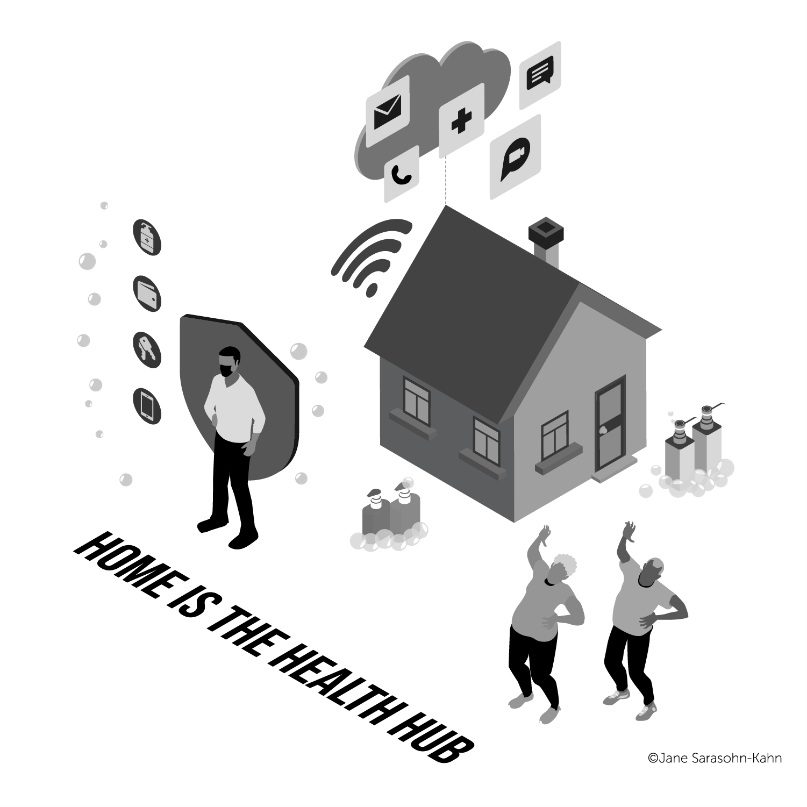 As January looms in a matter of days, I’ll be participating in the (all-virtual) 2021 CES, the annual gathering that usually convenes about 150,000 technology developers and consumers from all over the world. While we’ll be attending via our online platforms-of-choice this year, I know that digital health will continue to grow in its presence and pioneering innovations at the meeting, COVID-19 has surely inspired the world of consumer electronics as health citizens touched by the public health crisis around the world have digitally transformed for working, playing, cooking, and praying at home.
As January looms in a matter of days, I’ll be participating in the (all-virtual) 2021 CES, the annual gathering that usually convenes about 150,000 technology developers and consumers from all over the world. While we’ll be attending via our online platforms-of-choice this year, I know that digital health will continue to grow in its presence and pioneering innovations at the meeting, COVID-19 has surely inspired the world of consumer electronics as health citizens touched by the public health crisis around the world have digitally transformed for working, playing, cooking, and praying at home.
#CES2012 will launch many product announcements in wearable technologies and Internet of Healthy Things for the home. In addition, the connected car is evolving for wellness and safety, again in the pandemic a hygienic place for safely transporting alone or with one’s germ-pod family bubble to the pharmacy or grocery store.
Wearable tech is emerging as useful for COVID-19 signals: the Oura ring, for example, was shown to be useful for detecting the onset of fever, a key symptom of COVID-19 and the flu. This result came out as a first published result from TemPredict, studying over 65,00 people wearing the ring which tracks heart rate, activity, respiratory rate, and temperature. The study team is positioned to support data collected over time and across digital technologies – another trend we’ll see more of in 2021 as FHIR standards, interoperability, and cloud computing continue to proliferate the health care data ecosystem. Curating and analyzing these data points on consumers’ daily lives is part of a larger 2021 trend Gartner coined the Internet of Behaviors which will become increasingly integrated with health care plans and behavior change programs.
Telehealth for mental health democratizes access (for many) and reduces taboo. Speaking of “behaviors,” behavioral health and mental health have been key toxic side effects of the pandemic separate from the virus itself. The Great Lockdown and mandated working from home has led to people feeling isolated and even more lonely than they might have felt before they ever heard of the coronavirus.
At least six in ten Americans felt lonely as of January 2020 based on CIGNA’s research. The pandemic has exacerbated anxiety, depression, and stress. This mental health epidemic is a new normal in the U.S. and will persist after herd immunity is achieved in America. The pandemic accelerated investment in tele-mental health programs, which HealthXL inventoried in the middle of the pandemic.
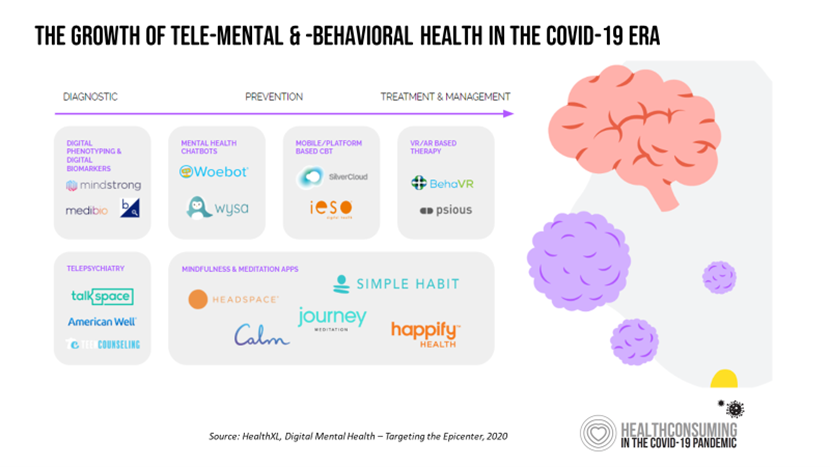 Demand for mental health services has exceeded supply in local markets: availability of therapists in many communities has been sparse and under-served, and for some consumers and communities, going to face-to-face therapy sessions has been taboo. The fast-growth of telehealth for mental health has been a boon in this situation and is positioned to quickly grow in 2021. This has been a major area for digital health investments during the pandemic, such as the Calm app scoring a $2 billion valuation in October and Modern Health raising $51 mm, among a long list of other deals in the virtual mental health space. This area will blossom in 2021 and benefit patients long over-looked by the real-time face-to-face therapist’s “couch.”
Demand for mental health services has exceeded supply in local markets: availability of therapists in many communities has been sparse and under-served, and for some consumers and communities, going to face-to-face therapy sessions has been taboo. The fast-growth of telehealth for mental health has been a boon in this situation and is positioned to quickly grow in 2021. This has been a major area for digital health investments during the pandemic, such as the Calm app scoring a $2 billion valuation in October and Modern Health raising $51 mm, among a long list of other deals in the virtual mental health space. This area will blossom in 2021 and benefit patients long over-looked by the real-time face-to-face therapist’s “couch.”
Sleep deficits, on the rise in the pandemic, will be better served for mainstream folks in 2021. Welcome to “COVID-somnia.” That’s lack of sleep occasioned by the coronavirus. A prevalent theme for wellness at CES for several years, sleep care is an area of behavioral health with growing demand due, again, to the pressures of the pandemic. Early in COVID-19’s emergence in the U.S., Express Scripts found new prescriptions for sleep medications experienced hockey-stick growth, shown in the chart. We can expect this demand to be served in 2021 in a variety of ways, under the sleep-as-medicine umbrella.
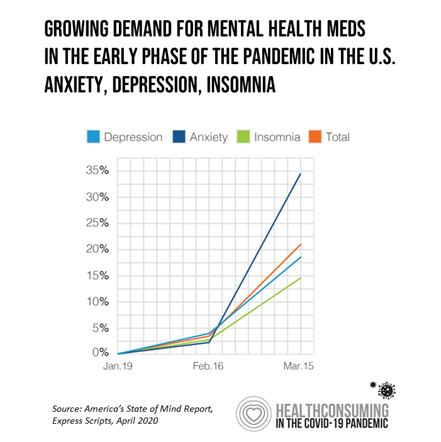 With growing adoption of value-based payment in health care, attending to the co-morbidity of insomnia will gain primacy. Sleeplessness compromises the patient’s ability to manage many chronic conditions, worsening heart issues, compromising weight loss in obesity, and other complications. Wearable techs that track sleep, medical devices for diagnoses (e.g., sleep apnea), and apps for meditation and sleep (e.g., Calm and Headspace among others proliferating in the pandemic) will become mainstream tools for self-care in 2021 and persist once the pandemic is declared over.
With growing adoption of value-based payment in health care, attending to the co-morbidity of insomnia will gain primacy. Sleeplessness compromises the patient’s ability to manage many chronic conditions, worsening heart issues, compromising weight loss in obesity, and other complications. Wearable techs that track sleep, medical devices for diagnoses (e.g., sleep apnea), and apps for meditation and sleep (e.g., Calm and Headspace among others proliferating in the pandemic) will become mainstream tools for self-care in 2021 and persist once the pandemic is declared over.
The grocery store advances as a health destination: Exhibit A, vaccines. COVID-19 solidified the role of the grocery store as a touch point for health, hygiene, and physiological needs fulfillment. In the first weeks of the #GreatLockdown, some food shoppers even leveraged the opportunity to engage in conversations with grocery store workers for socializing. In April 2020, H-E-B supermarket’s president implored consumers, ““If you come to the store, don’t come with your entire family…that way you lessen the ability for the virus to spread.”
A year later by April 2021, the grocery store combined with pharmacy will be a key channel for the delivery of the coronavirus vaccine for mainstream Americans.
The U.S. Department of Health and Human Services pressed supermarkets and retail pharmacy chains into service to bolster COVID-19 access in their communities. Part of the Federal government’s Operation Warp Speed to bring the coronavirus vaccine to market as quickly as possible, the Federal Pharmacy Partnership Strategy has enlisted over 20 drugstores and grocers in all 50 states to provide accessible, clean and convenient chain and community pharmacies to vaccinate Americans close to home, away from hospitals and doctor’s offices.
Before the pandemic, pharmacies were already major nodes of immunization for consumers seeking to get flu shots, stay current with children’s immunization schedules, and obtain adult jabs for shingles vaccines and adolescents’ HPV prevention.
In addition to grocers, retail pharmacy chains including CVS, Rite-Aid, Walgreens, and those in Costco and Walmart, will be major sites for channeling vaccination. To give you a sense of why retailers can be powerful partners in public health, note that 90% of the U.S. population lives within 10 miles of a Walmart.
Pharmacies located in grocery stores have grown as flu shot providers in the past few years, with pharmacists having conversations with shoppers about over-the-counter medications and foods to boost immunity.
The grocery store advances as a health destination: Exhibit B, food-as-medicine. In the wake of COVID-19, consumers have grown keen to select food items that can boost immunity. Consumers are getting more “in tune with immune,” Inova’s Consumer Survey 2020 forecasted for 2021’s food industry trends. Archer Daniels Midland has also looked into the Coronavirus’s impact on food shoppers’ behaviors, identifying a shift of people looking for immunity-boosting characteristics in their grocery shopping choices.
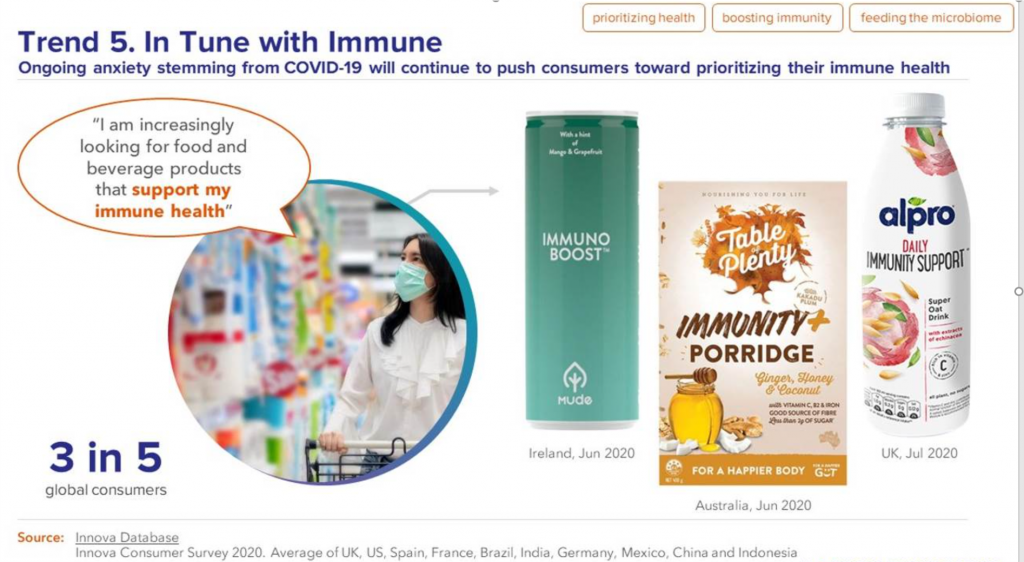 Beyond immunity, more consumers are looking to use food to bolster health, another trend accelerated by the pandemic as more people took to cooking at home and sourcing ingredients for the first time.
Beyond immunity, more consumers are looking to use food to bolster health, another trend accelerated by the pandemic as more people took to cooking at home and sourcing ingredients for the first time.
Food manufacturers are responding to consumers’ demand for healthier foods. Freshly, acquired by Nestle in the fourth quarter of 2020 in the second wave of the pandemic, will offer ready-to-eat meals under the FreshlyFit brand in 2021. This will coincide with peoples’ New Year’s Resolution season. Interestingly, the company’s marketing plan will be a digital-first approach. Freshly is also collaborating with Tonal, the home gym company that gained significant traction during the pandemic work-and-exercise-from-home mandate with offices shifting to workers’ dining rooms and gyms shifting from in-person exercise to homes-as-health-hubs.
In addition to Freshly expanding in the pandemic era, Blue Apron, the home cook subscription company, is pushing further into holistic wellness in 2021. Differentiating from other subscription meal-making offerings, Blue Apron’s refreshed messaging has to do with the different aspects of health and wellness, “better living through better food,” across physical, brain, relationship, mental and financial.
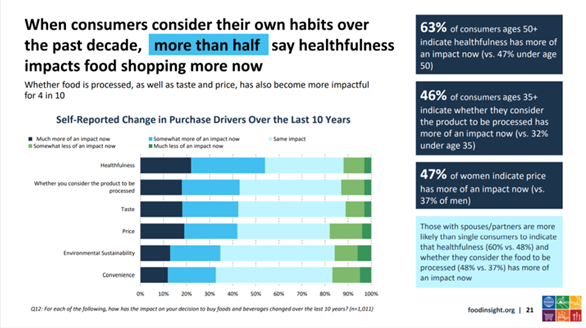 These trends hold for people able to, literally, put food on their tables spending money earned from working during the pandemic. However, millions of Americans continue to be without work, or are working reduced hours, as they look to a New Year in 2021. More Americans found themselves food-insecure in 2020, having to take advantage of food pantries across the United States. Food insecurity was also found to be a risk factor for people diagnosed with chronic conditions and mental health issues during the pandemic.
These trends hold for people able to, literally, put food on their tables spending money earned from working during the pandemic. However, millions of Americans continue to be without work, or are working reduced hours, as they look to a New Year in 2021. More Americans found themselves food-insecure in 2020, having to take advantage of food pantries across the United States. Food insecurity was also found to be a risk factor for people diagnosed with chronic conditions and mental health issues during the pandemic.
The digital transformation of consumers combines with the home as health hub and DIY as Aldi and Instacart joined forces to expand SNAP benefits online. The companies unveiled their SNAP EBT partnership in late October, rolling out the capability to more than 60 Aldi stores in Georgia in November and then to 570-plus Aldi stores in Illinois, California, Florida, Pennsylvania and Texas in early December.
As 2021 begins, the SNAP/EBT service is available through 90% of Aldi stores in the 29 states where the company operates in the U.S. The service works on Aldi’s button on Instacart’s website and mobile app, entering one’s EBT food card information for payment. Andrew Nodes, vice president of retail, explained. “As the country continues to grapple with COVID-19, we recognize the important role Instacart and its retail partners play in making same-day grocery delivery and pickup available to more people nationwide.”
The pandemic revealed an even greater need for privacy and security to bolster consumers’ trust in health data. Will privacy laws grow up for U.S. health citizens in 2021?
Google’s acquisition of Fitbit cleared European Union regulators last week, part of the EU’s workflow in addressing regulation of “Big Tech,” competition and market influence.
While the EU ultimately gave Google the go-ahead for the $2.1 billion purchase of Fitbit, there are conditions on the deal. The over-arching issue will be Google’s having to keep from using Fitbit’s huge repository of health and wellness data for ad targeting over ten years. The EU also reserves the right to renew this mandate for an additional ten years if they can justify the ask.
The EU is mandating that Google keep the data generated through Fitbit in a data silo separate from other Google data.
Fitbit users will also have the right to be forgotten, consistent with the GDPR law. In this case, EU health citizens have an “effective choice” to allow their Fitbit-generated personal health data stored in a Fitbit account or Google account to be accessible to various Google services (e.g., Google search, maps, assistant, YouTube, et al.).
When I live as a health citizen in Europe, I’m covered by the GDPR. In the U.S., not so much. From this side of the Pond in mid-2020, I had been tracking the Google+Fitbit discussions in the EU, noting a letter from Amnesty International to the EU to bolster human rights for consumer data.
Meanwhile, here in the U.S. on this side of the Atlantic, Senator Amy Klobuchar (D-Minn.) is closely watching the $65 Halo, Amazon’s newest wearable tech. She recently told the Washington Post, “I think that this is even more intrusive than many of these products — and I had already been concerned…This one just takes it to the Nth degree.”
From the user’s wrist, the Halo records activity and heart rate and can record the user’s voice through an embedded microphone. The Halo’s app can also analyze a user’s body mass index through naked photos the user can upload of themselves.
Senator Klobuchar wrote a letter to Secretary of Health and Human Services Alex Azar asking him questions about actions the DHHS would take to ensure fitness trackers protect user’s personal information and also asked whether additional regulations would be required to strengthen privacy and security for U.S. consumers’ health data given the growing Internet of Things for health.
[Interesting aside: the WashPo is owned by Jeff Bezos, Amazon’s founder and CEO].
The security question is hot right now as Germany had its first patient death tied to a ransomware attack. Hospitals, globally, have under-resourced cybersecurity investments, with worsened finances in the coronavirus era. These investments are expected to ramp up in 2021 as the health care industry has realized the escalating threat of ransomware attacks; the CISA, FBI, and DHHS communicating a warning of credible information of an increased and imminent cybercrime threat to U.S. hospitals and healthcare providers via this memo on October 28.
More recently, health care security experts are concerned that cyber attackers will target the COVID-19 vaccine supply chain and rollout. Furthermore, growing adoption of telehealth platforms require strengthening security across the virtual care ecosystem.
Consider uncertainties and wild cards for 2021. I’ve covered some of the certainties that set our consumer-facing health care table for 2021. There remain many uncertainties and wild cards to consider for short- and mid-term planning. Two of the biggest topics I’m brainstorming with my clients, through their health industry stakeholder lens (whether pharma, hospital, financial, technology, or consumer goods), are:
- The Biden Health Care Agenda: ACA v 2.0, regulation of prescription drug prices, and the financial health of Medicaid and Medicare; and,
- Business models for hospitals without beds.
Others that will be important include:
- The pace of economic recovery in the U.S. (which is now a “K”-shaped one, begging the question of how financially strapped Mainstream/Main Street Americans will be in 2021 and how that could impact self-rationing and the return to health care settings)
- The pace of vaccination in the U.S. and recovery of “lives and livelihoods” in different regions of America
- The “George Floyd effect,” as it was described in a year-end Economist magazine: how will a strengthening Black-lives movement impact public policy and business’s approach to diversity and inclusion in and beyond health care?
Finally, there is a big question I discuss in my book, Health Citizenship: How a virus opened up hearts and minds: that is, what is the new social contract for health post-pandemic in America?
 The new social contract for health is love. The U.S. public is split, largely by party, on whether getting a COVID-19 vaccine is a personal choice versus a collective responsibility, Kaiser Family Foundation observed in a poll conducted in early December 2020.
The new social contract for health is love. The U.S. public is split, largely by party, on whether getting a COVID-19 vaccine is a personal choice versus a collective responsibility, Kaiser Family Foundation observed in a poll conducted in early December 2020.
By the late spring of 2020, evidence gathered to support the wearing of face coverings, or masks, to stop the spread of the coronavirus. #WearTheMask was a trending hashtag, and fashion houses from Louis Vuitton to The Gap repurposed textile factories to manufacture masks as fashion statements.
Mask-wearing also became a political statement, with millions of people throughout the U.S. doubting the science behind face-covering, as the Pew Research Center found gaps between Democrats and Republicans shown in the chart.
In the U.S., we enter 2021 with these divisions between American health citizens.
I remain hopeful that our love of family and friends can be a unifying force for a new social contract for health in the New Year, the fourth pillar of our health citizenship in addition to health care access for everyone, digital citizenship for privacy and security of our personal data, and trust in science and in each other.
 The trend of business taking on more public health roles is part of a larger doubling-down on ESG goals – the environmental, social, and corporate governance objectives that are becoming a bar to c
The trend of business taking on more public health roles is part of a larger doubling-down on ESG goals – the environmental, social, and corporate governance objectives that are becoming a bar to c
ompete, not just a niche “nice to do” tactic.
The P&G campaign, “To Lead With Love,” brings together pro-social efforts with, well, love. The company is committing to do 2,021 “acts of good” in 2021. So many of the plans directly impact public health and social determinants, such as Feeding America, to bolster food security; addressing “period poverty,” where women lack funds to pay for women’s health products; the Puberty & Confidence campaign for girls’ health; and other projects dealing with health, hygiene, cleaning, and personal protective equipment (PPE), among other categories.
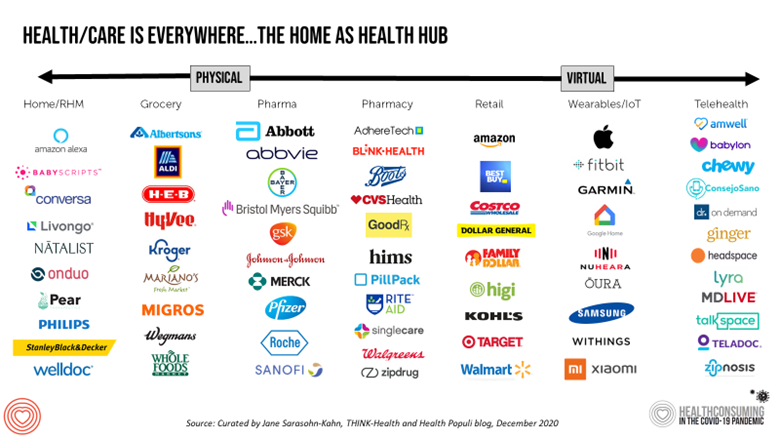 Healthcare morphs into retail and omnichannel. Leading with love is also part of a year-end campaign from Chewy, the online pet products, supplies and prescriptions company. In my ever-evolving retail health, everywhere, landscape, I recently added Chewy to the mix: here, under the “telehealth” segment.
Healthcare morphs into retail and omnichannel. Leading with love is also part of a year-end campaign from Chewy, the online pet products, supplies and prescriptions company. In my ever-evolving retail health, everywhere, landscape, I recently added Chewy to the mix: here, under the “telehealth” segment.
Just weeks after the COVID-19 pandemic emerged in the U.S., Chewy launched a telehealth company for pets, a tele-triage platform, “to preserve continuous veterinarian care and support amidst the COVID-19 pandemic.” It turned out that veterinarians were as concerned about their staff being exposed to COVID-19 as pet owners were about contracting the virus when taking their sick beloved fur babies to the vet’s office.
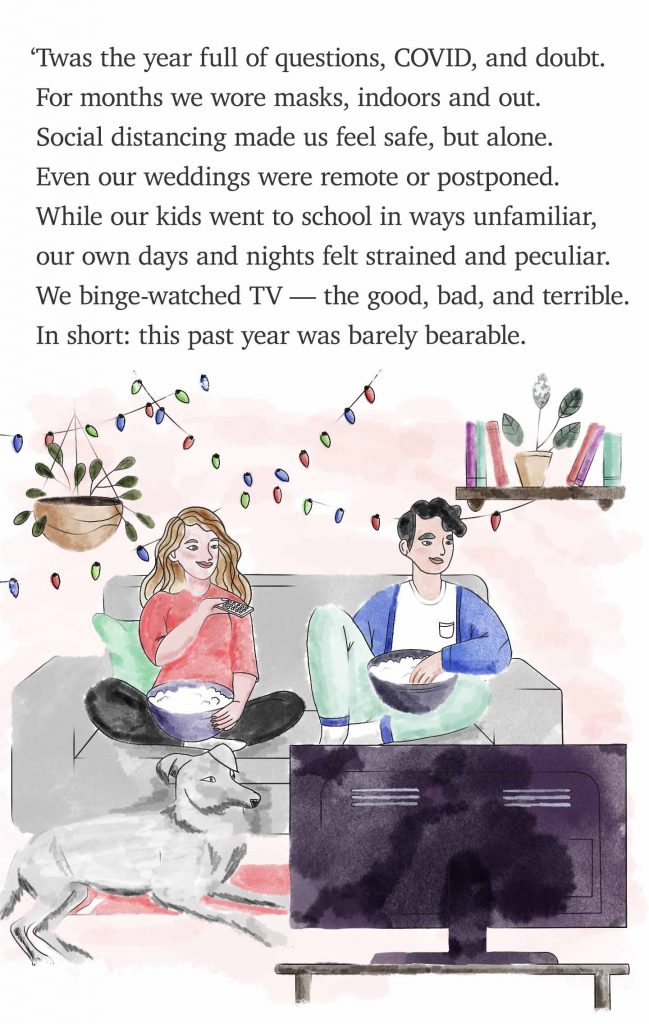 The weekend before Christmas, Chewy placed this poem, ‘Twas the Year Our Pets Saved Us, in major newspapers.
The weekend before Christmas, Chewy placed this poem, ‘Twas the Year Our Pets Saved Us, in major newspapers.
The poem begins, then continues with the stanzas below…
“‘Twas the year full of questions, COVID, and doubt,
For months we wore masks, indoors and out…
We care for our pets — they need us, it’s true.
But deep down we know that we need out pets, too…
We need the sense that their presence provides us:
The feeling that loved ones are always beside us.
We have it in ourselves to shift our attitude
And close out the year with a sense of gratitude.”
Onward to 2021, fellow health citizens! I wish you and those you love a healthy, resilient, joyful holiday season and New Year. May the vaccination commence, be inclusive and expansive, and lead us to in-person meet-ups, workplaces, eat-outs, travel where we want to go, and long overdue hugs.




 Interviewed live on BNN Bloomberg (Canada) on the market for GLP-1 drugs for weight loss and their impact on both the health care system and consumer goods and services -- notably, food, nutrition, retail health, gyms, and other sectors.
Interviewed live on BNN Bloomberg (Canada) on the market for GLP-1 drugs for weight loss and their impact on both the health care system and consumer goods and services -- notably, food, nutrition, retail health, gyms, and other sectors. Thank you, Feedspot, for
Thank you, Feedspot, for  As you may know, I have been splitting work- and living-time between the U.S. and the E.U., most recently living in and working from Brussels. In the month of September 2024, I'll be splitting time between London and other parts of the U.K., and Italy where I'll be working with clients on consumer health, self-care and home care focused on food-as-medicine, digital health, business and scenario planning for the future...
As you may know, I have been splitting work- and living-time between the U.S. and the E.U., most recently living in and working from Brussels. In the month of September 2024, I'll be splitting time between London and other parts of the U.K., and Italy where I'll be working with clients on consumer health, self-care and home care focused on food-as-medicine, digital health, business and scenario planning for the future...